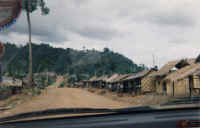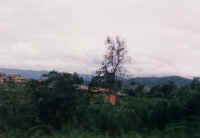Site K
Site K was a Khmer Rouge camp in Trat province of Thailand.
Sok San
Sok San was a KPNLF camp in Trat province of Thailand.


Thai / Cambodia Border Refugee Camps 1975-1999Information and Documentation Website |
|
|
Khao I Dang / Site II / 2 / Site B / Site 8 / Sok San / Site K / O'Trao |
Photos, Maps, Statistics, People, Places and Events |
Home - Border Camps - NGOs - UNBRO - Border History - Repatriation - Documents - Maps - Glossary - Links - About - Site Map - Contact
Site KSite K was a Khmer Rouge camp in Trat province of Thailand. |
Sok SanSok San was a KPNLF camp in Trat province of Thailand. |
 |
 |
Background
These two Khmer camps while on the surface separate camps of different factions were in fact adjacent to each other and joined by a road running behind the camps along the border.
Unlike Site II which was a dry and arid place these were lush jungle encampments and seemed more hospitable, less exposed.
Site K was the successor camp to Borai which had been the center of a concerted UN effort to remove the refugees from KR control.
Sok San was probably the most habitable of all the camps on the border. The Thai security was more relaxed, the Khmer administration was not repressive and the refugees could earn money working on the local large scale farms.
Programs
UNBRO was responsible for coordination of all matters relating to the provision of aid and assistance in the camps. They were directly responsible for food and water. All other support was provided by NGOs, either funded by the UN or privately.
Site K saw few visitors and fewer expatriates. There were no programs run by NGOs in the camp. UNBRO managed primary education and there was a camp officer for the two camps.
I visited Site K and the other KR camps to select candidates for the computer training program which IRC operated in Taphraya and Site II.
Sok San had a secondary school managed by COERR and Don Bosco had a vocational school in the camp. Medical support was provided by.......?
Population
Site K - 1991 - 10,866
Sok San - 1991 -9,485
* The KR camps were different from the other camps, more organised in their appearance and the people were more restrained in their demeanor, none of the natural Khmer curiosity and openess. Maybe it was my imagination but they seemed gray. O'Trao, Ta Mok's camp, was the grayest and most lifeless of the KR camps, Site K had a main road with some roadside shops and people were moving about more, Site 8 was the most open of the KR camps with programs operated by NGOs. Its residents were more open and less inhibited (a relative thing) than in the other KR camps.
Home - Border Camps - NGOs - UNBRO - Border History - Repatriation - Documents - Maps - Glossary - Links - About - Site Map - Contact
Web Services by
Send mail to with questions or comments about this website.
Last modified: 19/01/14
All photos by Richard Rowat unless otherwise specified